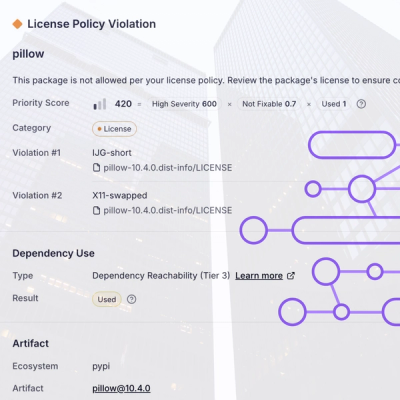
Research
/Security News
Critical Vulnerability in NestJS Devtools: Localhost RCE via Sandbox Escape
A flawed sandbox in @nestjs/devtools-integration lets attackers run code on your machine via CSRF, leading to full Remote Code Execution (RCE).
Transform environment variables into JSON object with sanitized values.
See docs for previous version v1.3.x.
Main purpose of this library is to allow developers to configure their applications with environment variables. See: a use case example.
separator option,nested object constructions are possible.source option allows you to use other objects, other than process.envdefault export is deprecated. Please use named export readEnv as below:const { readEnv } = require('read-env');
// Or
import { readEnv } from 'read-env';
// Or in browser
window.readEnv('EXAMPLE');
parse option was renamed as sanitize.transformKey option was renamed as format.ignoreInvalidJSON, prefix, filter,npm install --save read-env
or
yarn add read-env
Let's say you have some environment variables starting with prefix "EXAMPLE_" like below:
EXAMPLE_OBJECT='{"prop": "value"}'
EXAMPLE_ARRAY='[1,2,3, "string", {"prop": "value"}, 5.2]'
EXAMPLE_INVALID_OBJECT='{"prop": }"value"}'
EXAMPLE_INVALID_ARRAY='[1,2,3, "string", ]{"prop": "value"}, 5.2]'
EXAMPLE_TRUE='true'
EXAMPLE_FALSE='false'
EXAMPLE_INT='5'
EXAMPLE_NEGATIVE_INT='-11'
EXAMPLE_FLOAT='5.2456'
EXAMPLE_NEGATIVE_FLOAT='-2.4567'
EXAMPLE_INT_ZERO='0'
EXAMPLE_FLOAT_ZERO='0.00'
EXAMPLE_NEGATIVE_INT_ZERO='-0'
EXAMPLE_NEGATIVE_FLOAT_ZERO='-0.00'
EXAMPLE_STRING='example'
EXAMPLE_DEEP__OBJECT__PROPERTY='value'
app.js
import { readEnv } from 'read-env';
const result = readEnv('EXAMPLE');
console.log(result);
Result:
{
"object": { "prop": "value" },
"array": [1, 2, 3, "string", { "prop": "value" }, 5.2],
"invalidObject": "{\"prop\": }\"value\"}",
"invalidArray": "[1,2,3, \"string\", ]{\"prop\": \"value\"}, 5.2]",
"true": true,
"false": false,
"int": 5,
"negativeInt": -11,
"float": 5.2456,
"negativeFloat": -2.4567,
"intZero": 0,
"floatZero": 0,
"negativeIntZero": -0,
"negativeFloatZero": -0,
"string": "example",
"deep": {
"object": {
"property": "value"
}
}
}
readEnv(prefix?: string, options: ReadEnvOptions = {})Input:
prefix (type: string, default: undefined): filters environment variables by prefixoptions (type: ReadEnvOptions, default: {}): options object to change function's behaviourReturns: object (type: Record<string,any>), returns the instance, so add methods are chainable.
Default Options:
{
"source": process.env,
"format": "camelcase",
"separator": "__",
"sanitize": {
"object": true,
"array": true,
"bool": true,
"int": true,
"float": true
},
"includePrefix": false
}
options.sourceobjectprocess.envThe source object that will be filtered, sanitized and formatted.
Type Signature:
interface Source {
[key: string]: string | undefined;
}
options.formatboolean | string | functioncamelcaseFormat environment variable name.
It's value can be:
boolean, if set to false, formatting is disabledstring, one of which camelcase, pascalcase, lowercase, uppercasefunction, with (rawVarName: string) => string type signatureoptions.separatorboolean | string__Allows you construct nested objects from environment variable name.
false, constructing nested objects is disabledExample:
const { readEnv } = require('read-env');
const testInput = {
EXAMPLE_DEEP__OBJECT_PROPERTY1: 'value1',
EXAMPLE_DEEP__OBJECT_PROPERTY2: 'value2',
};
const result = readEnv('EXAMPLE', {
source: testInput,
});
console.log(result);
Result:
{
"deep": {
"object": {
"property1": "value1",
"property2": "value2"
}
}
}
options.sanitizeboolean | object,{}Sanitize object consists of following properties which is used to
object (type: bool, default: true): sanitize stringified object
value must be valid JSON input, see: JSON.parse.
array (type: bool, default: true): sanitize stringified array
value must be valid JSON input, see: JSON.parse.
int (type: bool, default: true): sanitize numbers into integer
value must be consist of only digits.
float (type: bool, default: true): sanitize numbers into float
value must be consist of only digits with decimal point.
bool (type: bool, default: true): sanitize value into boolean
value must have case insensitive match with "true" or "false".
options.includePrefixbooleanfalseIf set to true, keeps the given prefix in property names.
In past, I used Nightmare for acceptance testing and tests had different configurations based on the environment they were running on.
So, I simply used read-env, and nightmare is fully configurable with environment variables :)
import Nightmare from 'nightmare';
import { readEnv } from 'read-env';
const nightmareConfig = readEnv('MY_NIGHTMARE');
const nightmare = Nightmare(nightmareConfig);
Instead of writing code like below:
import Nightmare from 'nightmare';
const nightmare = Nightmare({
show: process.env.MY_NIGHTMARE_SHOW || false,
width: process.env.MY_NIGHTMARE_WIDTH || 1280,
height: process.env.MY_NIGHTMARE_HEIGHT || 720,
typeInterval: process.env.MY_NIGHTMARE_TYPE_INTERVAL || 50,
//... other properties go forever
});
As always, I'm open to any contribution and would like to hear your feedback.
If you are planning to contribute to any open source project, before starting development, please always open an issue and make a proposal first. This will save you from working on features that are eventually going to be rejected for some reason.
MIT (c) 2020 Mehmet Yatkı
FAQs
Transform environment variables into JSON object with sanitized values.
The npm package read-env receives a total of 25,312 weekly downloads. As such, read-env popularity was classified as popular.
We found that read-env demonstrated a not healthy version release cadence and project activity because the last version was released a year ago. It has 1 open source maintainer collaborating on the project.
Did you know?

Socket for GitHub automatically highlights issues in each pull request and monitors the health of all your open source dependencies. Discover the contents of your packages and block harmful activity before you install or update your dependencies.

Research
/Security News
A flawed sandbox in @nestjs/devtools-integration lets attackers run code on your machine via CSRF, leading to full Remote Code Execution (RCE).

Product
Customize license detection with Socket’s new license overlays: gain control, reduce noise, and handle edge cases with precision.

Product
Socket now supports Rust and Cargo, offering package search for all users and experimental SBOM generation for enterprise projects.